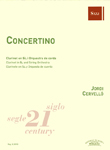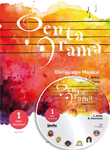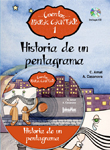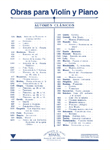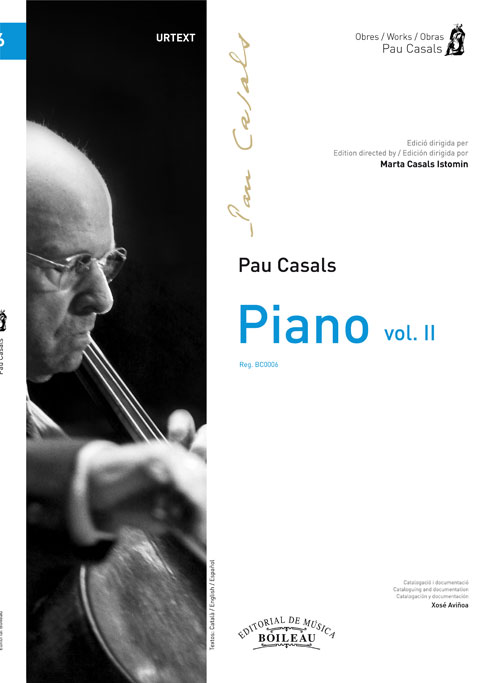Piano Vol. 2
Piano
CASALS, Pau; CASALS, PabloReg.: BC0006
23,70 €
P.V.P. (VAT included 4%)
Add to cart
- Arrangement: CAMELL, Jordi
- Review: CAMELL, Jordi; CASALS ISTOMIN, Marta
- Ensemble: Solo.
- Genres: Classical / contemporary: Solos.
Folk music / traditional: Sardanas.
- Product format: Partitura
- Difficulty level: Intermediate
- Period: 1st half S. XX
- Publishing house: Editorial Boileau
- Collection: Pau Casals
- No. of pages: 80
- Measure: 31,00 x 23,00 cm
- Lenght: 57'40"
- ISBN: 978-84-8020-907-6
- ISMN: 979-0-3503-0852-9
- Available in digital: No
- Available for rent: No
II.A-1 Cançó de bressol I [Lullaby I]
Score covering four manuscript pages bearing the following dedication: “A la meva filloleta Maria Helena Tharrats, pels seus primers reis, Pau Casals” [To my little god-daughter María Helena Tharrats, for her first Three Kings’ Day, Pau Casals]. It is also known by its subtitle Somni de l’infant [Child’s dream]. It is written in the key of A minor, with many alterations creating a rich, varied tonal environment which extends to the rhythmic aspect, playing with 9/8 and 6/8 times, with the particular feature of using doublets in ternary time signatures and quintuplets in binary time signatures. It ends with the signature “5. Gener 1935” [5 January 1935]. Maria Helena Tharrats i Vidal was the daughter of Casals’ friend Joan-Josep Tharrats i Vilà (Girona, 1886-Barcelona, 1975), the sister of the painter Joan-Josep Tharrats (1918-2001).
II.A-2 Cançó de bessol II [Lullaby II]
Work in G major and 2/4 time based on a simple, pleasant melodic line and an appropriate accompaniment for these values. There are two manuscripts, one of two pages with the title “Cançó de bressol” [Lullaby], ending with the signature “Prades, 22 de diciembre 1942. Per la meva nena estimada” [Prada, 22 December 1942. For my dear girl] and another of three pages, with the dedication “A Mariona Alavedra, pel seu Noël” [To Mariona Alavedra, for her Christmas]. It bears the signature “Prades, 22 de diciembre 1942” [Prada, 22 December 1942]. It is clear that the work was written for Joan Alavedra’s daughter at a time of close companionship during post-war exile.
II.A-3 Cor de pastors [Shepherds’ choir]
Brief, two-page piano score, one of whose themes, slightly modified and appropriately orchestrated, came to form part of his more complex work El pessebre [The crib]. Naturally, it has a choral texture for four voices and shows that at this time Casals was already working on his symphonic/choral magnum opus. It bears the title “Cor de pastors Nadal 1942. A l’estimat Macianet” [Shepherds’ Choir, Christmas 1942. To dear Macianet] and it is written in the key of E flat and 6/8 time. It follows a schematic crotchet-quaver/crotchet-quaver design, modulating from E flat major to B flat major, returning to E flat major and a diminuendo ending with long values. It is a simple piece designed, like the previous one, to be used by those to whom it is dedicated. It ends with the signature “Prades, 24 de Diciembre 1942” [Prada, 24 December 1942].
II.A-4 Poema de bressol [Lullaby poem]
Work for piano with the dedication “A la Sra. Rita Casals de Güell en la naixença de la seva filleta Anna Maria” [To Mrs. Rita Casals de Güell on the birth of her little daughter Ana María]. It is in the key of A minor and 4/4 time. The first section, very simply crafted, makes a slight modulation in A major on a slow theme, the second section in pp develops on sets of quavers, also alternating A minor and A major; the third “poco más lento” [slightly slower] section plays with crotchet chords and occasional modulations. Finally, the last section uses long, arpeggiated values, slowing down with an arpeggiated finale in pianíssimo. It bears the signature “Prades Octubre 1943” [Prada October 1943].
II.A-5 Prélude
On the cover of the eight-page manuscript appears the indication “Prélude pour piano” [Piano Prelude], dated “Prades 15 Août 1943” [Prada 15 August 1943] and the dedication “À Madame Charles Lafabrègue”. It is a work initially in the key of A minor and 2/4 time, bearing the agogic indication “Andante” and showing a characteristic vertical development. The work is designed in various sections, the first based on a crotchet chord design in 2/4, some of them arpeggiated, and transition scales; a second section “Poco più mosso”, dominated by legato quavers, with an appasionato crescendo leading to left-hand arpeggios based on chromatic chords with the right hand, some of them impossible. The last section is once again slow. Its outstanding feature is the song accompanied by arpeggios that leads to the finale. It bears the completion date “Prades 1946” [Prada 1946].
II.A-6 Alla Menuetto
Brief piano work of two and a half pages in the key of E major, with a second theme in A major which goes back to the da capo in 3/4 time. It follows one of the composer’s habitual textures, with many alterations creating an evocative harmonic environment and, as its title indicates, its nature is that of an elegant dance work. It does not have a signature at the end (1955). It is a work which, throughout its discourse, maintains a pattern of three crotchets, a crotchet and four or six quavers, in all cases with a clear ternary rhythm. From bar 63, the key changes to A major and, from then on, the left hand plays with triplet figures of three quavers while the right hand continues with the two-quaver figures. The score is dedicated to M. Horszowski. Miecislaw Horzowski (1892-1993) was a precocious pianist who astonished the people of Barcelona, particularly Joan Maragall, when he visited the city to give a concert in January 1906. He shared a great friendship with Pau Casals throughout their respective long lives.
I.A-11 Festívola Sardana
The original score, a nineteen-page manuscript, indicates on the cover “Festívola, Sardana per cobla, Estrenada el dia de Santa Agna (26 de juliol) per la Cobla Olotina” [Festívola, Sardana for cobla, Premiered on Saint Anne’s Day (26 July) by the Cobla Olotina]. It begins in the key of F major and 2/4 time and maintains the habitual structure in the genre; harmonically it is very blank, with an occasional modulation to B flat major. It was published by Musical Emporium and bears no signature (1909). There is a four-page manuscript with the reduction for piano published by J. M. Llobet and stamped “Beneficencia Vendrell”, which also bears no signature. It is a sardana danceable with curts [the first 39 bars] and llargs (the rest of the bars down to 161).
II.D-1 “Melodía Pelegrí” Sardana
The three-page manuscript score bears the following indication “De la part melòdica d’aquesta sardana n’és autor ‘El Pelegrí’, el graller famós mig segle enrera. Coordinada i harmonitzada per P.C.“ [The composer of the melodic part of this sardana is “El Pelegrí”, the famous gralla player of half a century ago. Coordinated and harmonised by P.C.] It begins with the soloist playing, presenting the “Pelegrí” theme in 6/8 and F major; it then modulates into B flat major, lightly evoking the theme, moving into D major, B minor, B major, or, exceptionally, B# major. In the score, llargs and curts are not indicated. It bears the signature “Sept. 1927”.
II.D-3a Sant Martí del Canigó Sardana
Four-page manuscript with the sardana for piano in C major and 2/4 time, forming part of the work El misteri del sant [The mystery of the saint]. A simple and very popular sardana, not difficult to perform. The initial bars (curts) evoke ringing bells, although without any indication in the score. The second part (llargs) is constructed around the basic chords A minor and E major. It bears the dedication “A la meva nena estimada” [To my dear girl] who, from the chamber orchestra version, we know was Maria de la Pau Tortelier, daughter of the ‘cellist Paul Tortelier (1914-1990). It ends with the signature “Prades 24 Février 1943” [Prada 24 February 1943].
II.D-4 Sardana in C major
A four page manuscript titled Sardana, in the key of C Major with a time signature of 2/4. There is no known publication of this work. It was probably a piano sketch for a sardana which the composer did not subsequently arrange for performance. The work begins with a rhythmic motive for the two hands in unison. The ending is sonorous with accents and long crescendo marked in the score. Sardana was composed in exile and was dedicated to “la pétite Michèlle Puig”. There is a date at the end of the manuscript: “Prades Noël 1943”.
Addendum Variations,Chorus of the Shepherds
The editor of this edition, Jordi Camell, has composed this work inspired by the original by Pau Casals. It is a virtuositic response, in some case with new harmonies, in which Camell, who has recorded and edited all of Casals’ piano works, pays hommage to this great musician and composer.
Cançó de bressol I (3'18")
Cançó de bressol II (1'35")
Cor de pastors (2'42")
Poema de bressol (6'13")
Prélude (5'30")
Alla Menuetto (6'45")
Sardana Festívola (7'00")
Sardana "melodia Pelegrí" (6'00")
Sardana Sant Martí del Canigó (6'53")
Sardana en Do Major (6'50")
Annex: Variacions
Cor de pastors (3'00")


